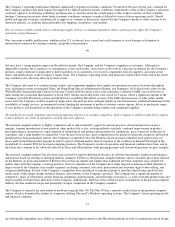Apple 2003 Annual Report Download - page 27
Download and view the complete annual report
Please find page 27 of the 2003 Apple annual report below. You can navigate through the pages in the report by either clicking on the pages listed below, or by using the keyword search tool below to find specific information within the annual report.
The Company orders components for its products and builds inventory in advance of product shipments. Because the Company's markets are
volatile and subject to rapid technology and price changes, there is a risk the Company will forecast incorrectly and produce or order from
third-
parties excess or insufficient inventories of particular products or components. The Company's operating results and financial condition in
the past have been and may in the future be materially adversely affected by the Company's ability to manage its inventory levels and
outstanding purchase commitments and to respond to short-term shifts in customer demand patterns.
Gross margin increased to 27.9% of net sales in 2002 from 23.0% in 2001. Gross margin in 2001 was unusually low resulting from negative
gross margin of 2% experienced in the first quarter of 2001. As a
31
percentage of net sales, the Company's quarterly gross margins declined during fiscal 2002 from 31% in the first quarter down to 26% in the
fourth quarter. This decline resulted from several factors including a rise in component costs as the year progressed and aggressive pricing by
the Company across its products lines instituted as a result of continued pricing pressures in the personal computer industry.
Operating Expenses
Operating expenses for the three fiscal years ended September 27, 2003 are as follows (in millions, except for percentages):
Research and Development (R&D)
The Company recognizes that focused investments in R&D are critical to its future growth and competitive position in the marketplace and are
directly related to timely development of new and enhanced products that are central to the Company's core business strategy. The Company
has historically relied upon innovation to remain competitive. R&D expense amounted to approximately 8% of total net sales during 2003,
2002 and 2001, up substantially from approximately 5% of total net sales in fiscal year 2000 and recent earlier periods. The Company's
management believes that maintaining or increasing the pace of innovation and product development is the best way to respond to current
economic and market conditions and will continue to position the Company for future growth as conditions improve. R&D expense increased
6% or $25 million to $471 million in 2003 as compared to 2002, which follows a $16 million increase in 2002 as compared to 2001. The
overall increase in R&D expense relates primarily to increased headcount and support for new product development activities. R&D spending
also included capitalized software development costs of approximately $14.7 million related to the development of Mac OS X Panther in 2003;
approximately $13.3 million associated with the development of Mac OS X Jaguar and approximately $6 million associated with the
PowerSchool enterprise student information system in 2002; and approximately $5.4 million associated with the development of the original
version of Mac OS X in 2001. Further information related to the Company's capitalization of software development costs may be found in
Part II, Item 8 of this Form 10-K at Note 1 of Notes to Consolidated Financial Statements.
Selling, General, and Administrative Expense (SG&A)
SG&A increased $103 million or 9% during 2003 as compared to 2002 due primarily to the Company's continued expansion of the Retail
segment and increases in headcount. The overall increase was partially offset by a decrease in current year discretionary spending on marketing
and advertising and by savings resulting from the 2003 and 2002 restructuring activities described below.
SG&A decreased $29 million or 3% during 2002 as compared to 2001. The decrease in SG&A in 2002 was primarily the result of lower
discretionary spending on marketing and advertising expenses, decreased spending related to information systems, and benefits directly related
to the Company's restructuring actions in 2002 and 2001. The decreases were partially offset by higher sales expense in 2002 resulting from
increased operating expenses associated with expansion of the Company's Retail segment.
32
Restructuring Actions
2003
2002
2001
Research and development
$
471
$
446
$
430
Percentage of net sales
8
%
8
%
8
%
Selling, general, and administrative expenses
$
1,212
$
1,109
$
1,138
Percentage of net sales
20
%
19
%
21
%
Restructuring costs
$
26
$
30
—
Purchased in
-
process research and development
—
$
1
$
11
























